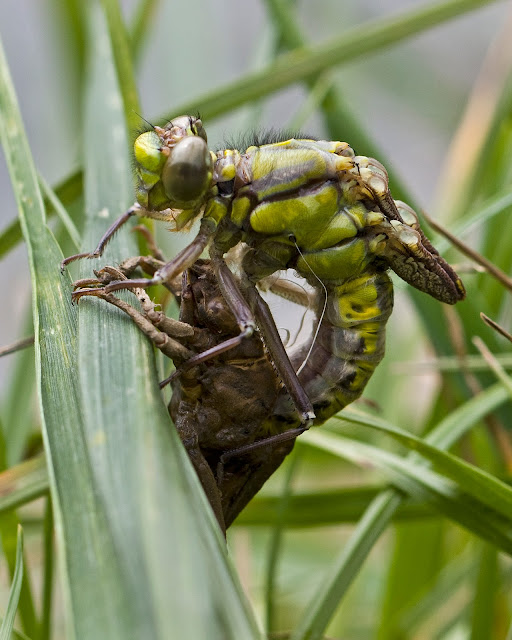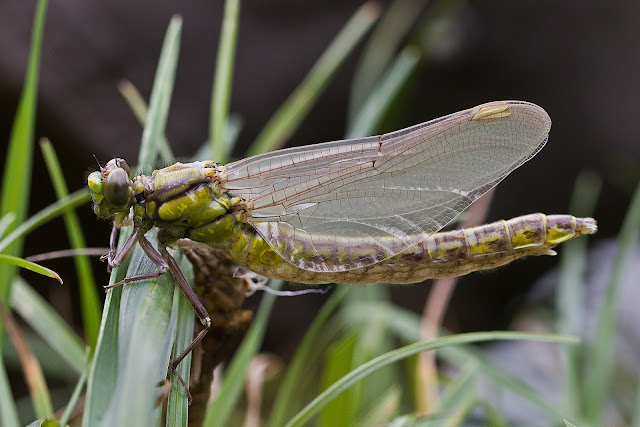Having dipped the Common Clubtail Dragonfly on the Arun yet again, Dave and I decided on a trip up to Goring-on-Thames to look for them. They would still not be easy to find, but at least we knew there had been recent sightings.
The hot spot was the railway bridge over the Thames about a mile east of Goring. We parked up in Goring just after nine and walked the river bank to our destination, searching likely vegetation and objects along the bank for any sign of our target. Our estimates of success had not been high when we arrived, probably around 20%. By the time we got to the railway bridge they were down to just two or three percent. The weather was much cooler than we had expected, there were no insects flying anywhere and certainly no signs of Clubtails.
Hopes were raised when we met a fellow odonatist who knew a bit more about the local Clubtail population than we did. He pointed out Exuvia close to the bridge that we had missed and told us where to look for emerging specimens.
 |
| Common Clubtail Exuvia |
Re-energised we searched again. We found more exuvia but with the time just coming up to one o'clock there was still no sign of an emerging larva. We had thought that emergence would only be in the morning and were just about to give up and head for home when Dave found a specimen that had climbed the wall that we were searching and was out on the grass.
 |
| Emerging Common Clubtail Larvae. |
The location was not ideal for obtaining a photographic record but we did not want to move the larvae or do anything that could compromise its final emergence as a Dragonfly. The following pictures record that emergence over a period of just over an hour.
 |
| 12.50 Drying out |
 |
| 13.02 Thorax pumping up, laval cuticle begins to split |
We would have been a bit disappointed if a Four-spotted Chaser had popped out at this point. We also had an interesting discussion over the point it actually becomes a Clubtail Dragonfly and gives us the life tick. Geek or what?
 |
| 13.04 Head emerges |
 |
| 13.05 Thorax and first segments out |
 |
| 13.06 Legs coming out |
 |
| 13.08 Legs out |
 |
| 13.09 No action for a few minutes as the legs harden |
 |
| 13.16 Using hardened legs to withdraw the rest of the body |
 |
| 13.17 Body out but wings still compressed |
 |
| 13.17 Body fluid being pumped through the wing veins to expand the wings |
 |
| 13.23 Wing expansion continues |
 |
| 13.29 Wings fully expanded, body fluids now pumped to expand the abdomen |
 |
| 13.36 Nearing completion |
 |
| 13.40 Drying wings, seems to be disposing of excess body fluids |
 |
| 12.41 Nearly ready to fly |
 |
| 12.53 Just before short first flight |
 |
| 12.58 A few feet from emergence point, still drying wings and preparing for longer flight |
And then it was gone. I like to think that we watched over it and safeguarded it during this vulnerable period. Birds were probably not too much of a threat but there were dogs about and it could have been at risk from humans like us searching the river bank.
Just to prove it wasn't a fluke here is a second one we found just before leaving. This was in a bit more precarious position gripping the stone wall overhanging the river.
A bit of a slow start but in the end a great day and two very satisfied photographers. Just one problem, we still don't have that Sussex tick! No, two problems, this is only a teneral, where do we find a mature adult?

Just brilliant!
ReplyDelete